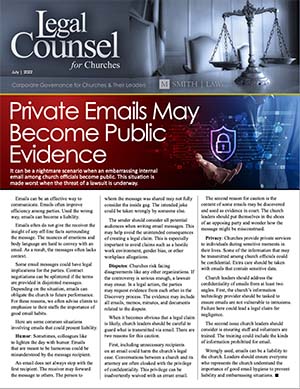Most leaders face the question of capital adequacy for their institutions. Having insufficient capital can empower or handicap an organization’s plans.
This is a conversation around the amount of reserves a church should have on hand. In this article, we share a governance perspective on the dialog around capital.
Capital is the church’s savings account for a rainy day. Capital is important because it provides a financial cushion for future perils. Officials who focus on building capital recognize the need to be prepared for what may come.
Capital is defined as the net assets of a church. Capital is calculated by subtracting the total liabilities from total assets. The difference is the church’s net financial value.
Knowing the capital of a church is important for strategic reasons. Churches face some of the same uncertainties as other organizations. Church leaders who are involved in strategic planning should have
a firm grasp on the organization’s capital standings. To make prudent decisions, leaders must put a financial valuation on each risk and set aside reserves should the threat happen.
Capital cushions the church against foreseeable risks. This stash of reserves prepares the ministry for disruptions in its revenues from economic, weather, or public health events. Today’s inflation, supply-chain disruptions, and market uncertainties present risks church leaders should consider. Risks threaten to eat away at the church’s capital.
Church leaders also are faced with opportunities as well. Opportunities offer the prospects for the church to prosper in some way. Endeavors to expand the ministry, create new programs, and improve infrastructure often require financial commitments.
The key to mitigate risks and exploit opportunities, is knowing how much capital to have on hand. Sufficient capital improves the church’s resilience to disruptions. Excess capital provides room to invest in new ways to advance the ministry.
Church leaders should determine how much capital is enough. To make this decision, officials must calculate three values. First, determine how much capital is required to meet current legal obligations. This may come about if the church has a bank loan with a minimum liquidity covenant. This restriction obligates the church to keep a certain amount of capital set aside as collateral for the loan.
Second, the monetary value of the likely risks should be factored into the equation. This analysis involved looking at the community and the church membership to find where weaknesses exist. For instance,
a community that is heavily employed by a single company presents a concentration risk to the church. If that employer is operating in a declining industry exposed to market disruptions, the blow back on the church could be significant. The church leaders may put aside reserves for the possibility many of their members could face financial difficulties.
Finally, setting aside a budget for prospective opportunities becomes the last consideration. This factor materializes after leaders have a strategic conversation in a planning process. Here, the leaders identify ways to expand the ministry, assign a dollar value to each venture, and plan financial allocations towards the goals.
The capital adequacy calculation should be reviewed periodically. Doing so helps church leaders stay abreast of emerging risks and opportunities.
Church leaders have a fiduciary duty to plan. Knowing how much capital should be set aside for the future is an important responsibility. As officials think ahead for the traditional fall planning sessions, capital adequacy should be on the agenda.

